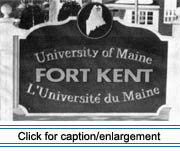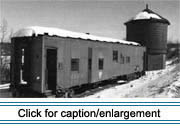|
 The range of organizations that might present some aspect of the Maine
Acadian story to the public or preserve Maine Acadian culture is quite
broad. It includes social clubs with an educational and cultural focus,
schools, community organizations, chambers of commerce, archives and libraries,
arts groups, and historical societies and museums. Constituencies could
be international, national, state-wide, or local.
The range of organizations that might present some aspect of the Maine
Acadian story to the public or preserve Maine Acadian culture is quite
broad. It includes social clubs with an educational and cultural focus,
schools, community organizations, chambers of commerce, archives and libraries,
arts groups, and historical societies and museums. Constituencies could
be international, national, state-wide, or local.
In consultation with the Maine Acadian Culture Preservation Commission,
the planning team identified more than 125 organizations as potential
"cooperators" with the National Park Service. The team has consulted with
over 50 of these. For the most part, cultural conservation efforts in
the Upper St. John Valley have been initiated by community-based, volunteer
historical societies.
 A primarily local focus directs the work of historical societies such
as St. Agatha, Fort Kent, Frenchville, and St. Francis, while a few groups
maintain both a community and regional focus. The Acadian Village in Van
Buren, for example, preserves and displays a collection of historic houses
from throughout the Valley. The Madawaska Historical Society has been
a leader in regional efforts to celebrate Maine Acadian heritage since
the 1970s. The society initiated the annual Acadian Festival, maintains
a regionally-oriented publications program, and commemorates the early
settlement of the Valley at the Acadian Landing Site. L'Association culturelle
et historique du Mont-Carmel strives to interpret religious architecture
and the influence of religion in the Valley, and provide a venue for cultural
programming.
A primarily local focus directs the work of historical societies such
as St. Agatha, Fort Kent, Frenchville, and St. Francis, while a few groups
maintain both a community and regional focus. The Acadian Village in Van
Buren, for example, preserves and displays a collection of historic houses
from throughout the Valley. The Madawaska Historical Society has been
a leader in regional efforts to celebrate Maine Acadian heritage since
the 1970s. The society initiated the annual Acadian Festival, maintains
a regionally-oriented publications program, and commemorates the early
settlement of the Valley at the Acadian Landing Site. L'Association culturelle
et historique du Mont-Carmel strives to interpret religious architecture
and the influence of religion in the Valley, and provide a venue for cultural
programming.
Over the past 20 years conservation initiatives associated with the French
language have been largely focused on the educational system. The Northern
Maine Bilingual Education Project has been working in local schools since
the 1970s. In 1993 a Valley-wide "Committee to Save Our French" was formed
by Valley residents interested in reviving and preserving the French language
for the younger generation.
|
 |
 |
 The
University of Maine at Fort Kent preserves and fosters an appreciation
of the Acadian and Franco-American heritage by providing a home for the
Acadian Archives/Archives acadiennes, emphasizing the French language
and bilingual/multicultural concerns, and cooperating with nearby Canadian
universities. The Acadian Archives/Archives acadiennes was established The
University of Maine at Fort Kent preserves and fosters an appreciation
of the Acadian and Franco-American heritage by providing a home for the
Acadian Archives/Archives acadiennes, emphasizing the French language
and bilingual/multicultural concerns, and cooperating with nearby Canadian
universities. The Acadian Archives/Archives acadiennes was established at the University of Maine at Fort Kent in 1989. It is a repository and
resource center, offering on-site consultation regarding archival collections
and information about regional folklore, history, and folklife. Several
other agencies of state government have also been involved in conservation
of Maine Acadian culture.
at the University of Maine at Fort Kent in 1989. It is a repository and
resource center, offering on-site consultation regarding archival collections
and information about regional folklore, history, and folklife. Several
other agencies of state government have also been involved in conservation
of Maine Acadian culture.
The Maine Bureau of Parks and Recreation maintains the Fort Kent Historic
Site and has expressed interest in participating in future cultural conservation
efforts in the Upper St. John Valley. Over the years other state agencies
involved in Valley projects include the Maine Arts Commission, Maine Historic
Preservation Commission, Maine Humanities Council, and the Maine State
Museum.
 Cultural organizations have had success in preserving material culture
and folklore of the Upper St. John Valley. Historic structures and artifact
collections offer opportunities to interpret Maine Acadian culture. Historic
houses, barns, and churches--which provided arenas for daily activities--are
complemented by tools, furnishings, and religious items used by Maine
Acadians in everyday life. Documentary and archival materials related
to the Valley provide grounding for an examination of Maine Acadians'
lives. Local and state organizations and individuals are concerned about
the future of Maine Acadian culture and present a wide range of potential
National Park Service partners.
Cultural organizations have had success in preserving material culture
and folklore of the Upper St. John Valley. Historic structures and artifact
collections offer opportunities to interpret Maine Acadian culture. Historic
houses, barns, and churches--which provided arenas for daily activities--are
complemented by tools, furnishings, and religious items used by Maine
Acadians in everyday life. Documentary and archival materials related
to the Valley provide grounding for an examination of Maine Acadians'
lives. Local and state organizations and individuals are concerned about
the future of Maine Acadian culture and present a wide range of potential
National Park Service partners.
|
|

